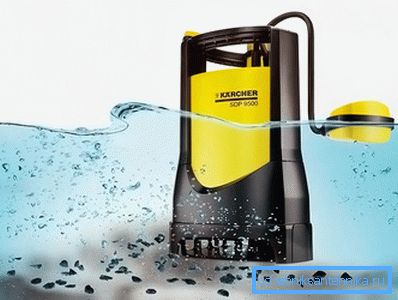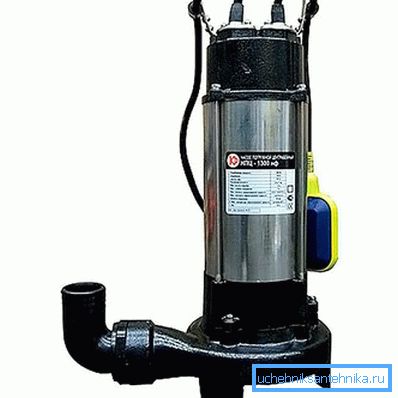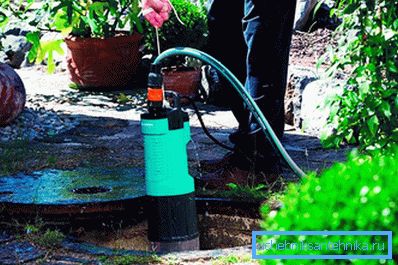How to choose a pump for pumping sewage
Suburban housing is characterized by the autonomy of many engineering systems: water, wastewater, heat supply. Various local treatment systems are used for the disposal of liquid waste: from simple cesspools to high-grade cleaning systems with biological and chemical processing. Reliable, continuous operation of the entire sewer system: pipes, pits or septic tank depends on the proper operation of all elements, one of which are pumps for pumping or pumping out drains. The owner of a country house, independently constructing the drain and cleaning system, you need to learn how to choose a pump for pumping sewers.
A pump is a technically complex and expensive product with certain parameters. The classification of pumps is carried out according to the constructional and functional principle.
Which can be used

Depending on the tasks for sewage drainage or fecal pumps are used. They have a significant difference, although many perceive them as one type of pump by function.
- Drainage pumps. Easily cope with pumping water, including dirty, from places filled with water. This may be a pool, basement, sump, septic tank with a liquid fraction. The pump cannot pump out liquids with solid particles above 50 mm.
- Fecal pumps. More powerful, have enlarged flow channels. This allows pumping solid fractions (feces, garbage, food waste, etc.) with polluted water. They will help pump out waste with a particle size of up to 80 mm from cesspools, septic tanks. It can be used for forced pumping of sewage from the sewer system.
Design differences

Structural fecal pumps can be 4 types.
Without a grinder of large solid fractions:
- For pumping cold drains. The maximum temperature of drains allowed to pump out is 40 ° C. These are the simplest models suitable for emptying pools, basements and other containers with clean or polluted water.
- For pumping out hot drains. Maintain temperatures up to 90 ° C. Used for the treatment of wastewater in the bath, sauna, where the water does not have large solid fractions.

With chopper:
- For cold drains. Able to pump sewage from the toilet, cesspool. Paper, hair, feces easily crushed by mechanical incisors and pumped out with polluted water. Enjoys the most popular.
- For hot drains. Allow to pump out liquids up to 90 ° C with hard fractions that are mechanically cut. Scope of application - saunas, baths with a toilet.

According to the type of installation, the pumps are divided:
- The submersible pump is capable of operating when fully immersed in drains. Installed permanently at the bottom of the sump or septic tank. Has vertical or horizontal execution. The engine is fully protected from moisture, the case is resistant to aggressive environments.
- The semi-submersible pump does not fully fall into the drains. The engine is at the top, and the intake part is immersed in impurities. Semi-submersible pumps do not have shredders, therefore they are not suitable for pumping feces and other solid waste. The pump must be mounted on a float that rises and falls with the level of liquid waste.
- External pumps are installed separately from the tank with waste. Pumping of liquids occurs through the intake hoses. Used for pumping pools, storage tanks with liquid waste. The absence of shredders does not allow the use of these pumps for emptying cesspools and septic tanks. The maximum height (the depth of the lowering of the suction hose) to which the pump is capable of raising liquid drains is 3–4 m.
Recommendations for use

The variety of types and variants of pumps allows you to select the appropriate model.. To determine which pump is best to buy, it is necessary to consider the conditions in which the pump will operate. However, it is better to follow some recommendations that contribute to the long life of the pump:
- The pump capacity must exceed the maximum design loads and be at least 25 m3/ h
- Installation location of the pump. The operating point allows you to determine the effective operation of the pump without overloading. It is recommended to reduce the maximum parameters by 2 times.
- The diameter of the conditional passage (outlet). The larger the size, the more wastewater the pump can pump out with contaminants consisting of solid fractions.
- Maximum head. This is the height at which the pump is able to lift water (on average, not more than 10 m), or the distance that can pump liquid in a horizontal direction (up to 120 m).
- Engine cooling Oil (recommended option) or due to the pumped liquid.
- The location of the pipes. Vertical is preferable, since for the horizontal it will be necessary to make adapters.
- The quality of the materials of the pump casing and its internal components. Plastic, cast iron will reliably protect from external aggressive environment.
If you want to share personal experience on the choice and operation of the pump for pumping sewage, then write comments to the article. Need expert advice? Contact us! The specialist working on our site will kindly provide you with additional information.
Video
In this video we are talking about the choice of drainage and fecal pump: